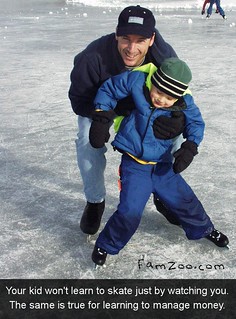“Set a good example!”
That tip inevitably ranks high in the typical Top N list for teaching kids good money habits.
Sure, setting a good example is an excellent thing to do as a parent, but the advice makes me cringe in this case for two reasons: complacency on the one hand and paralysis on the other.
If you already have good money habits as a parent, the classic set-a-good-example advice encourages complacency. You might start thinking: “Hey, I have good money habits, and my kids will absorb them through osmosis. My work is done here!” Don’t bank on it. First of all, the nuances and context of your good money habits may not be visible, understandable, or relevant to your child without substantial explanation. Think about how much of your financial reality your child doesn’t see or get. And what about hands-on experience? You wouldn’t expect your kid to learn how to ice skate just by watching someone else do it, would you? Like any skill, personal finance requires practice to master and maintain.
That’s why I like this quote by Rachel Cruze from Chapter 1 of the book Smart Money Smart Kids:
Being Dave Ramsey’s daughter didn’t guarantee that I’d never struggle with money; knowing and applying Dave Ramsey’s principles did.
(Why am I reading the new book by Dave Ramsey and his daughter, Rachel Cruze? See the first post in this series here.)
So, it isn’t sufficient just to be a personal finance icon for your kids. You need to explicitly teach your kids about money. Then, you need to provide an environment in which your kids can apply that knowledge on a regular basis. Repetitive practice is what turns the knowledge into lasting habits.
Is setting a good example with money for your kids even truly necessary? That may sound downright heretical, but what if your money habits leave something — or even a lot — to be desired? The set-a-good-example maxim leaves you feeling paralyzed and intimidated. You might be thinking: “I don’t have good money habits myself, so I have no business teaching my kids good money habits. Therefore, I’ll wait until I have my financial house in order.” Big mistake. Some studies claim that financial habits form as early as age 7. You can’t afford to wait. Start teaching your kids now, and get your financial house in order together.
As Rachel points out in Chapter 1, Dave didn’t wait to get his financial house fully in order before resolving to teach his kids about money. He started right away. Rachel, the youngest, was just 6 months old when Dave filed for bankruptcy. Dave’s story is a rags to (fleeting) riches to rags to (lasting) wealth story — fascinating for those who haven’t heard it (as was the case for me). In the remainder of the chapter, Rachel describes what it was like “growing up Ramsey.” It sets up the back-story nicely for the rest of the book. You can see a bit more of the back-story in this quick trailer video for the book:
So, implicitly communicating good money habits by setting a good example is certainly laudable, but explicitly and intentionally teaching your kids good money habits through hands-on coaching and practice is a must. It’s an extraordinary gift to your child that keeps on giving. As Rachel remarks:
From the very beginning, my parents gave me a legacy of debt-free living, and that’s one of the best gifts any parent could ever give their kids.
Hear, hear!
Click here to go to the next post in the review series: Connecting the Dots Between Money and Work for Your Kids
The full series:
- Teaching Kids Good Money Habits the Ramsey Way: Introduction
- Setting a Good Money Example for Your Kids: Sufficient? Necessary?
- Connecting the Dots Between Money and Work for Your Kids
- Striking a Balance with Kids and Money
- 4 Big Things Your Teen Can Save For




 NEWER
NEWER

2 comments:
Great post! I love the blog as well!
Thank you for stopping by Leslie, and thank you for the kind words on the blog!
Post a Comment